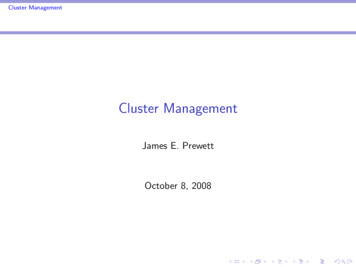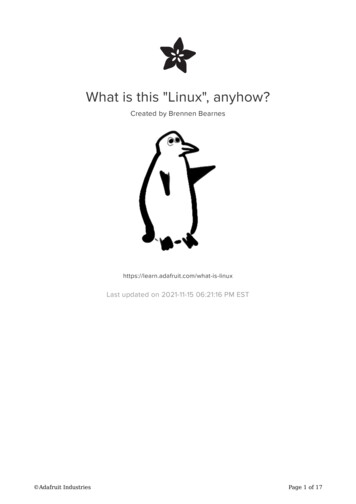
Transcription
DissectingLinux/MooseThe Analysis of a Linux Router-based WormHungry for Social NetworksOlivier Bilodeau& Thomas DupuyMay 2015
DissectingLinux/MooseThe Analysis of a Linux Router-based WormHungry for Social NetworksOlivier Bilodeau& Thomas DupuyMay 2015
TABLE OF CONTENT1. Executive Summary42. Hunting SeasonIntroduction53. Moose’s Behavioran Overview64. Moose HerdingThe Operation84.1. Moose population — Prevalence114.2. Moose habitat— Targeted devices144.3. Moose Motivation — Why Social Networks?144.4. Moose Taking Selfies — Deep into Instagram154.5. Multiple trails in the Moose yard — Alternative Attack Scenarios195. Moose DNAMalware Analysis215.1. Moose Reproduction — Infection Vector235.2. Going Deep in the Tundra — Spreading Past Firewalls325.2. Moose Crossing — Proxy Service375.4. Moose’s Sense of Smell — Sniffing Capabilites425.5. Competitive Moose — Cleaning other Malware445.6. Moose Communication — Configuration C&C Server Protocol455.7. Evolution of the Species —Malware changelog506. Conclusion51Appendix A: Malware samples52Appendix B: Indicators of Compromise (IOCs)53Network-based Indicators53Host-based Indicators53Detection (yara)54Appendix C: Cleaning55Appendix D: Prevention56Appendix E: Potentially targeted vendors57
LIST OF TABLETable 1.Report Telnet login protocol25Table 2.Reply to Telnet login report26Table 3.Report shell access protocol28Table 4.Report shell access response28Table 5.Partial List of Moose's Configuration Flags30Table 6.Moose Configuration Values Affecting the Behavior of the NAT Traversal34Table 7.Moose relay C&C server response34Table 8.Moose NAT traversal supported commands35Table 9.Proxy Server Worker Commands38Table 10.Report sniffed packet43Table 11.Response to a report sniffed packet43Table 12.Moose requests to configuration C&C server45Table 13.Moose configuration C&C server response46Table 14.Moose header configuration C&C server response46Table 15.Moose whitelist item47Table 16.Moose sniffer configuration item48Table 17.Malware Samples52LIST OF FIGURESFigure 1Linux/Moose overview7Figure 2Proxy Traffic per Destination Port8Figure 4HTTPS Destination AnalysisFigure 5Proxy activity categorized by destination type11Figure 6Port 10073 Activity12Figure 7Scanning behavior over 24 hours13Figure 8Instagram Proxied HTTP Traffic16Figure 9Moose Components21Figure 10Moose Scanner Behavior24Figure 11Reporting a Peer Found to the Configuration C&C Server24Figure 12Report Telnet login example26Figure 13Moose Infection Mechanism26Figure 14Scan from the Internet or near home32Figure 15Netmask check33Figure 16Loopback check33Figure 17NAT traversal tunnel in action36Figure 18Moose Whitelist Validation Assembly37Figure 19Example of a SOCKS 4 tunnel39Figure 20Looking for CONNECT method40Figure 21Sniffing Network Traffic42Figure 22Capture of a Configuration Exchange with C&C4510
Dissecting Linux/Moose1. EXECUTIVE SUMMARYLinux/Moose is a malware family that primarily targets Linux-based consumer routers but that caninfect other Linux-based embedded systems in its path. The compromised devices are used to stealunencrypted network traffic and offer proxying services to the botnet operator. In practice, thesecapabilities are used to steal HTTP Cookies on popular social network sites and perform fraudulentactions such as non-legitimate "follows", "views" and "likes" on such sites.Linux/Moose is a standard statically-linked ELF binary that was stripped of any debugging symbols.It relies heavily on multithreading for its operation using as many as 36 threads. Most of thesethreads are used to attempt find and infect other devices automatically.The threat displays out-of-the-ordinary network penetration capabilities compared to otherrouter-based malware. Moose also has DNS hijacking capabilities and will kill the processes of othermalware families competing for the limited resources offered by the infected embedded system.ESET researchers ran and monitored a Moose-infected environment and collected operationalinformation about the threat. This information includes which social networks were targetedand the unencrypted interactions between the operators, the infected host and the targetedsocial networks.Linux/Moose does not have a persistence mechanism and does not provide a generic backdoorshell access to the botnet operator. No vulnerability is exploited at any time during its operation;it spreads by finding routers with weak credentials.This report contains an overview of the operation and an in-depth analysis of the threat, detailsof its network protocol, indicators of compromise (IoC), cleaning instructions, prevention adviceand the list of potentially targeted vendors.Key findings Linux/Moose targets consumer routers and modems including the hardware providedby Internet Service Providers (ISPs) to consumers The threat is built for deep network penetration spreading past firewalls It can eavesdrop on communications to and from devices connected behind the infectedrouter, including desktops, laptops and mobile phones Moose runs a comprehensive proxy service (SOCKS and HTTP) that can be accessed onlyby a specific list of IP addresses The operators use the infected devices to perform social network fraud on Twitter,Facebook, Instagram, Youtube and more Moose can be configured to reroute router DNS traffic, which enables man-in-the-middleattacks from across the Internet It affects Linux-based embedded devices running on the MIPS and ARM architectures3
Dissecting Linux/Moose2. HUNTING SEASONIntroductionAt ESET we like to investigate exotic threats. Whether they run on atypical architectures like MIPSor ARM, or they target embedded networked devices — like consumer routers or Internet of Things(IoT) devices — instead of desktops or phones or they are designed to obscure their end goal, thesethreats arouse our curiosity. There are other reasons, of course, for a threat to be considered exoticbut, the threat under study here fits all the above categories. In fact, the only thing that’snot exotic about it is the name we’ve given it: Linux/Moose1. Well, at least for those of usat ESET Canada Research.This report is divided into two sections: a description of what we know about the operation, followedby a detailed technical description of the threat. Before going in too deep into the operation, though,we need to give you a high-level sense of what Moose can do.1For the curious: the original malware binary filename as installed on the router is elan2. Élan is Frenchfor Moose.4
Dissecting Linux/Moose3. MOOSE’S BEHAVIORan OverviewThe high-level capabilities of this worm are: Replicate on the Internet and by way of any LAN interfaces behind firewalls Service listening on port 10073 that allows specific IP addresses to proxy through the infecteddevice. HTTP/HTTPS and SOCKS proxying Tunnel traffic from a relay C&C server to other hosts (effectively circumventing NATprotections) Eavesdrop on network communications and send some of the captured traffic to a reportC&C server Periodically kill processes launched by competing embedded malwareInterestingly, missing from this list is the persistence mechanism (there isn’t any) and the factthat no generic backdoor shell access is made available to the botnet operator.Last but not least, this threat spreads only by compromising systems with weak or defaultcredentials. No vulnerabilities are exploited by the malware. Although downplayed by systemadministrators, this attack vector has been effective at compromising a lot of Internet-connectedsystems. As FireEye recently stated: “Brute forcing credentials remains one of the top 10 mostcommon ways an organization is first breached.”As we have found out, the malware’s main payload — its generic proxy service — is used solelyto perform social network fraud. The story is similar for stolen traffic which targets browser cookies.5
Dissecting Linux/MooseWith that understanding we summarize the threat graphically ]Scanning all networksfor devices to infectOther routersDVRSocial network fraudFigure 1Linux/Moose overviewLinux/Moose will periodically communicate with a set of command and control servers (C&C)that are hardcoded into the malware itself. The randomly picked C&C server, henceforththe configuration C&C server, will provide configuration information that will affect the behaviorof the malware. In that configuration two IP addresses will be referred to several times in this report:the IP address of the C&C server to use for reporting and infection, dubbed the report C&C server,and the IP address of the C&C server to use for relay (NAT traversal), dubbed the relay C&C server.6
Dissecting Linux/Moose4. MOOSE HERDINGThe OperationWhen looking at the broad possibilities of this malware it is not immediately obvious whatits exact purpose is. It could go in many directions, from DDoS, to compromise of networks,and expose private servers to the operator (via proxy), steal important yet unencrypted traffic,or perform man-in-the-middle attacks via DNS hijacking.It was not until we were able to decrypt our first configuration from the configuration C&C serverthat we were able to start to grasp what the operators were after. When we started running our owninfected devices then the purpose became crystal clear.This threat is all about social network fraud.First, analysis of the configuration indicated that the data that the bot is trying to stealis HTTP cookies from popular social networks. Twitter: twll, twid Facebook: c user Instagram: ds user id Google: SAPISID, APISID Google Play / Android: LAY ACTIVE ACCOUNT Youtube: LOGIN INFOAdditionally, by monitoring one infected router — which we firewalled in order to prevent it frominfecting others — we were able to establish the nature of the traffic proxied through these routers.We collected this proxy data for almost a month in the spring of 2015.4%Operator (HTTP)0%Others18%HTTP77.64%HTTPSFigure 2Proxy Traffic per Destination Port7
Dissecting Linux/MooseWhat is highlighted here is that most of the traffic going through the proxy is encrypted. The operatortraffic is carried via HTTP over a non-standard port (TCP 2318). It is used to communicate the externalIP address of the infected device to the client at the other end of the proxy. It is worth noting that mostof the HTTP traffic is for the Instagram social network and is upgraded to HTTPS right away usinga Location: header.Figure 3Instagram server upgrades client connection to HTTPS usinga Location headerThe SOCKS proxy overhead (1) and the redirection to use HTTPS instead of HTTP (2) can be seenin the capture.Although we can’t see the content of the encrypted traffic, we can look at the destinationIP address. Furthermore, we can inspect the certificate identifying the server and its CommonName (CN) — a mandatory attribute that allows to authenticate the website — giving us an accuratedescription of the destination of the proxied traffic.8
Dissecting Linux/Moose2%59%3%4%YandexSoundcloudYahooOthers (Youtube, Yandex, Yahoo)1%47%Amazon CloudInstagram37%49%YoutubeTwitter / VineFigure 4HTTPS Destination AnalysisDuring our monitoring, the top 3 targets were Twitter, Instagram and Soundcloud. We regroupedthe "Others" in a separate pie chart to make the graph readable.In addition to the encrypted data, we looked at the autonomous systems (AS) where the proxiedtraffic was going and cross-referenced it with passive DNS information. Using this method we wereable to compile the list of targeted organizations below: Fotki (Yandex) Instagram (Facebook) Live (Microsoft) Soundcloud Twitter Vine Yahoo Youtube (Google)9
Dissecting Linux/MooseWe can also look at how much requests are made through the proxy and for what purpose wasthe proxy used. This is summarized in the below graph.Figure 5Proxy activity categorized by destination typeSocial networks is the number of proxy requests with a destination related to social networkingsites as identified by the certifacate CN, passive DNS information or the IP address AS. botnet trafficis the number of proxy requests sent to C&C and was always related to the previously mentionedTCP port 2318. Other is any proxy request that didn’t fit the above categories. The graph highlightsthat infected hosts are leveraged only to access social networks and that, on average, more than500 requests per day will go through an infected router.Unfortunately, since most of the traffic is encrypted, we can only speculate about what they aredoing, even though we can make a shrewd guess. We will get to that eventually but first lets lookat how big this threat is.4.1. Moose population — PrevalenceDespite all our efforts we were unable to make a reliable estimate of the number of affected routers.This is due in part to the fact that the malware was built to make it hard to make an estimate. Thereis no peer-to-peer protocol, it uses a hardcoded IP address instead of DNS for C&C, and even thoughthe backdoor is listening on the Internet on port 10073 to offer its proxy service, only IP addresses ina whitelist are allowed to connect. Another reason for our lack of success is the lack of security toolsecosystems (like Anti-Virus) on embedded systems. Finally, the hosting providers where the C&C arelocated were relunctant to cooperate, which didn’t help.This section will list all other attempts we have made at estimating the population of this malware.10
Dissecting Linux/MooseProbes on the InternetSomething we can use to give us a sense of the activity level of this threat is the general networkactivity on the Internet Storm Center’s probes regarding port 10073. Since this port is unassignedby the IANA, and is not in use by any popular software, abnormally high volumes of trafficon that port could be an indicator of Moose activity.Port 10073 ActivityFigure 6Port 10073 ActivityAlthough we couldn’t find precise documentation, we believe that sources and targetsrepresent whether the packet seen on the ISC’s probe going for port 10073 was from the sourceside or the target side of the probe. In themselves the numbers might paint an incomplete picture,since the probes are seeing just a subset of the Internet traffic — but if we compare them with HTTPStraffic over the same period, we see that Moose activity was roughly only an order of magnitudebelow HTTPS.We can also see a clear rise in 2014 that is too sharp to be statistically irrelevant. We first met Linux/Moose in late July 2014. Since the beginning of 2015 there seems to be a decline in activity but weknow that the operators are still active since they keep updating their malware. The fact that theycan remotely control the intensity of scanning activity on port 10073 might account for the apparentdecline in traffic.11
Dissecting Linux/MooseMoose AggressivenessAnother measure of prevalence is the aggressiveness with which the bot spreads. We ran one infectedhost for 24 hours and measured its level of activity and its success rate at finding potential peers orconnecting to exposed Telnet services. Here are our results:Telnet Hosts withLogin Prompt10073 ConnectionAttemptsPotentiallyInfected HostsTelnet ConnectionAttempts18000018010073 Responding Hosts135000135TelnetResponding Hosts9000090450004500Figure 7Scanning behavior over 24 hoursOver 24 hours, almost 170000 connection attempts were made on port 10073, meantfor 23000 unique hosts. Of those, 36 completed the TCP handshake, which means that they mightbe infected, or they have another service on this port2, or they are firewalled weirdly3. 85000 Telnetconnection attempts were made on 18000 unique hosts, of which 161 responded with a login banner.These numbers have to be taken with a grain of salt since they depend heavily on the type of hardwareon which the malware runs. We ran it under software emulation — which is usually way slowerthan real hardware — in a virtualized Intel server — which is way more powerful than most routers.In other words, we don’t know how these numbers compare to real infected hardware but we tendto think that they should be comparable.Internet scanFinally, we asked our friends at Rapid7 to scan the Internet on both port 10073 and 23 (Telnet)in order to get a sense of how many Internet-facing devices listen to both ports. It turns outabout 1 million IP addresses fit that description. If we remove the devices that had no Telnet banner,that number is reduced to around 50,000 potentially infected hosts. Still, this number is probablyan overestimate because of the wild nature of the Internet and yet might also be an under estimatesince many publicly unreachable and therefore uncounted devices might be infected.All of these indicators taken together, while only educated guesses, leads us to think that this threatis real and should be taken seriously.2Although possible, we randomly inspected a sample of the servers and saw very few with actual respondingservices on the 10073 port3TCP FIN instead of RST or dropping the packets, which is usually the best practice12
Dissecting Linux/Moose4.2. Moose habitat— Targeted devicesLinux/Moose requires a Linux-based system because of its dependency on µClibc, a popular C libraryfor embedded systems. Plenty of embedded systems are now running Linux — from consumer routersto carrier-grade network gear through Internet of Things (IoT) appliances.Some affected devices are easier to identify than others. For instance: upon launch, the malwarechecks whether the file /home/hik/start.sh exists on disk. This path is usually associated withHik Vision DVRs which are being targeted by embedded malware. Another means of identificationis to look at what routers support the methods used to perform DNS Hijacking. Last but not least isto look at what devices are affected by the threats that Linux/Moose tries to eliminate when it runs.Here is a list of vendors we know are being targeted:Vendors Confirmed as Being AffectedActiontec, Hik Vision, Netgear, Synology, TP-Link, ZyXEL, ZhoneIoT but even medical devicesBased on recent security research we have enough evidence to state that evenmedical devices like the Hospira Drug Infusion Pump could be infected withLinux/Moose. Of course, just as is the case with IoT, these devices are currentlymore collateral damage than deliberate targeting.Due to time constraints and hardware availability, we have been unable to confirm so farthat certain vendors are definitely targeted. We would love to be able to crowdsource an accuratetargeted vendors list. See the full list of potentially targeted vendors in the appendixes for vendornames and validation instructions.As to why some of these devices would ever be attacked by the malware? Well, there is the malware’sability to reach behind firewalls but we must not forget what we have learned in 2012 viathe Carna Botnet:A lot of devices and services we have seen during our research should never be connectedto the public Internet at all. As a rule of thumb, if you believe that "nobody wouldconnect that to the Internet, really nobody", there are at least 1000 people who did.Whenever you think "that shouldn’t be on the Internet but will probably be found a fewtimes" it’s there a few hundred thousand times. Like half a million printers, or a MillionWebcams, or devices that have root as a root password.— Internet Census 2012 (Carna botnet)4.3. Moose Motivation — Why Social Networks?During our analysis we often asked ourselves, “Why so much effort in order to interact with socialnetworks?” Then we realized that there is a market for follows, likes, views and whatnot. It is prettyclear that this is what is going on here.First, as previously mentioned, there are attempts at stealing cookies from these sites. However,the cookies cannot be stolen if the traffic is HTTPS and now most of these sites are HTTPS-only,so it’s unclear how effective these attacks are in this respect.Second, attempting to commit fraud upon these sites needs a reputable and disposable IP address.If someone tries to register 2000 twitter accounts from his own IP address this will likely drawattention. To a social network site operator, there is probably nothing more reputable thanan IP address behind a well-known ISP. Just the type of network where you can expectto find badly configured consumer routers.13
Dissecting Linux/Moose4.4. Moose Taking Selfies — Deep into InstagramThe non-operator-related HTTP traffic we were able to observe was of the well-known Instagramsocial network.During our monitoring we were able to see more than 700 different Instagram accounts accessedfrom a single infected router over about a month.Accounts freshly created that we’ve seen in the tunnels:When we checked the next day, the account had started to follow around 30-40 people:14
Dissecting Linux/MooseThis is no isolated case. Both these accounts were seen in the HTTP traffic and then a few hourslater when we checked them they were already following a similar number of accounts. It feelsas if the operators understand there to be some threshold value that must not be reached too quickly.Looking more closely at one account, here is a Wireshark screenshot of the HTTP traffic. You cansee the username in the highlighted Location header 4.Figure 8Instagram Proxied HTTP TrafficAfter a few hours we have a user with 36 followers:4Sharp-eyed readers will also notice the server’s redirection to HTTPS ending our ability to monitor thecontent of the network traffic15
Dissecting Linux/MooseWho is he following?We picked an account at random. Carefully avoiding accounts with pictures that would require someblurring we’ve hit an account with surprisingly many followers considering that it has seven postsand follows only seven accounts:16
Dissecting Linux/MooseAfter one week it got better:We have also found accounts that are following many similar accounts:17
Dissecting Linux/MooseLike this one selling Facebook likes:By looking at the tunnel activity we were able to witness many instances of fraudulent socialnetwork activity. It seems that people are willing to pay for this, so it is understandable that criminalswill try to leverage it.4.5. Multiple trails in the Moose yard — Alternative Attack ScenariosLooking purely at the capabilities of Moose, several attack scenarios can be extrapolated. Howeverdue to the complexity of monitoring this threat most of them couldn’t be confirmed. We will quicklyexplore the more interesting ones here.Distributed Denial of Service (DDoS) attacksLike most botnets, DDoS capability is a possibility. In this case there is nothing built into the malwareitself that is related to DDoS but the generic SOCKS proxy implementation allows it. Howeverit doesn’t seem realistic to waste bandwidth through proxies instead of performing direct attacks.Network explorationTargeted network exploration and eavesdropping is definitely possible with Moose due to itsNAT traversal capabilities and its integrated network sniffer, which is configured by a C&C server.The operator could tweak and monitor more closely one infection based on the IP addressof the infection if it were affiliated with a government or a bank, for instance.18
Dissecting Linux/MooseReconnaissance then DNS HijackingOne technical limitation of Moose is that it can only perform its DNS hijacking payload on victims' routersduring infection. However this is not enabled in the default C&C configuration5 and so we wonderedhow it could be used.Here is a credible attack that the operator could launch to leverage several pieces of Moose’sfunctionality and that would enable a reinfection of victims in which their DNS would get hijacked.Note1.This plan requires knowledge about the malware that hasn’t been covered yet.Some of the missing pieces will be explained further along.Infect a few network devices within close range, such as badly configured consumer routersbehind the same ISP2. Sniffer is activated and waits for HTTP Cookies3. Credible browsing activity occurs and operator receives all the cookies4. Once confirmed to be an interesting target, configuration from the C&C changes: testingfor infected host before going to Telnet is disabled, DNS hijacking is enabled and scannerthreads are rebalanced to favor the infection of closely related IP addresses insteadof random ones5. Reinfection will happen as the scanner reinfect hosts already infected (due to the disabledcheck). During the reinfection the rogue DNS IP addresses will be put in place.6. Users behind compromised routers will have their DNS hijackedAt this point the rogue DNS servers can point legitimate sites to phishing sites, inject malwarein downloaded files, or perform man-in-the-middle attacks that would prevent upgrades to HTTPSby websites.5Which is good for them since they don’t need to give out the malicious DNS IP address in the configurationinformation. Something we would have definitely explored if it were available.19
Dissecting Linux/Moose5. MOOSE DNAMalware AnalysisLinux/Moose is a statically linked ELF binary without debugging symbols. It uses µClibc as its C library.It relies heavily on multithreading with more than 30 running simultaneously during a usual infection. file elan2elan2: ELF 32-bit MSB executable, MIPS, MIPS32 version 1 (SYSV), statically linked,strippedWe based our analysis on the MIPS variants of the threat. The screen captures in this report are takenfrom this architecture. We quickly analyzed the ARM variant to make sure that this is the same threatand track changes through time, but that’s all.Here is a diagram of the various components of the threat that we will develop in the following sections.actionContact configurationC&C serverC&CRaw socketthreadsEavesdrop networkrecvfromContact reportC&C serverConnectBruteforcePropagate LANPropagateInfectContact reportC&C serverContact reportC&C serverContact relayC&C serverNAT travelsalConnectPropagate WANBruteforcePropagateInfectContact reportC&C serverOne hourServer TCP: 10073ListenNAT traversalHTTP ProxyForward trafficFigure 9Verify whitelistNetwork I/OMoose Components20Server workerthreadSOCKS ProxyContact reportC&C server
Dissecting Linux/MooseString obfuscation with C&C serversBefore we move on to describe the individual components, there is one thing that is commonbetween many of the components: The obfuscation that is applied to the strings sent throughthe network.Strings obfuscated with this simple algorithm can be made readable with the following Python snippet:def decrypt cnc msg(ct):"""Decrypt stringsct: bytearray of the ciphertextreturns bytearray of the plaintext"""# seedk 0xfffor i in reversed(range(len(ct))):# XOR with previousk ct[i] ct[i] kreturn ct5.1. Moose Reproduction — Infection VectorWe classified Moose as a worm since it attempts to replicate automatically. In this section we willdescribe how its spreading mechanism works.NoteSeveral parameters provided by the server configuration packet are of interestto understand the spreading behavior. The parameter names have been made upbased on the behaviors they modified. The full list and details of these parametersis available in the configuration C&C network protocol section.After configuration, three sets of threads are created that are related to the spreading mechanism:threads scanning random IP addresses, threads scanning closely related IP addresses, and threadscreated per network interface to scan these otherwise unreachable networks. These threads sharethe same code, which we will refer to as a scanner thread. The scanner thread’s behavior is alteredby being passed a different configuration.Scanner threads and configurationInterestingly the number of threads per set is defined by the configurationC&C server. cnccfg nb thdscan local defines how many threads shouldscan for IPs closely related to the external IP. cnccfg nb thdscan ext defines how many threads should scan using random IPs. Lastly, if cnccfg flagscanner sniffer is set, then a scanner thread will be launched per additional network interface on the system — something we cover later.During the observation period, typical configuration values seen coming from the configurationC&C server were: 10 threads scanning random IPs 20 threads scanning closely-related IPs 1 thread per network interface scanning local-area networks usually protectedby the routers themselves21
Dissecting Linux/MooseScanner threadsThe three sets of threads are each bootstrapped a bit differently. One set is scanning purely randomIP addresses, another one is scanning for random IP addresses that are in the same /15 subnet (CIDR)as the external IP address of the infected device, and the last one is incrementally scanning all the IPson the network interfaces it found up to the interface’s broadcast address.Random scanInternet13.3.3.7/1513.3.3.7Closely-related IP addresses( random scan in the same /15 ofthe router’s external IP address )192.168.1.0/2410.13.3.0/24Other interfaces( linear scan from .0 to .255 )Figure 10Moose Scanner BehaviorThe scanner performs the following operations on each IP. First, it checks going to see if it canconnect on TCP port 10073. If it can perform a full TCP handshake, it will disconnect right awayand considers that the host is already infected and will report it as such to the report C&C server.22
Dissecting Linux/MooseA Moose Encounter — An Infected Host (Peer) was FoundUnlike the other configuration C&C server interactions, which happen using a custom binary protocolon port 81, this exchange is done in HTTP on that same port. Here is an example that was captured:Figure 11Reporting a Peer Found to the Configuration C&C ServerServer headersThe server headers here are interesting. This Apache server version hasn’tbeen released (and probably won’t be for another century). Furthermore, to thebest of our knowledge, Redhat has never been capitalized "RedHat" in ApacheServer h
3 issecting LinuMoose 1. EXECUTIVE SUMMARY Linux/Moose is a malware family that primarily targets Linux-based consumer routers but that can infect other Linux-based embedded systems in its path.










